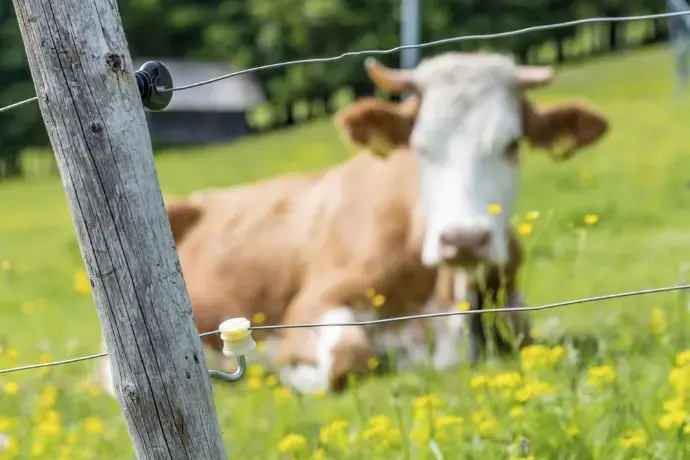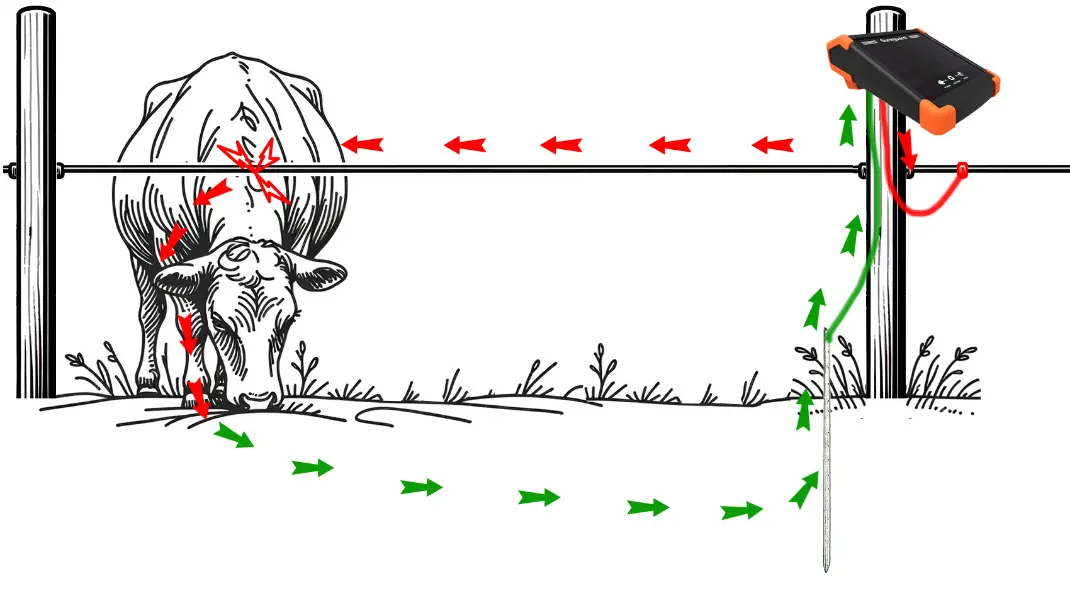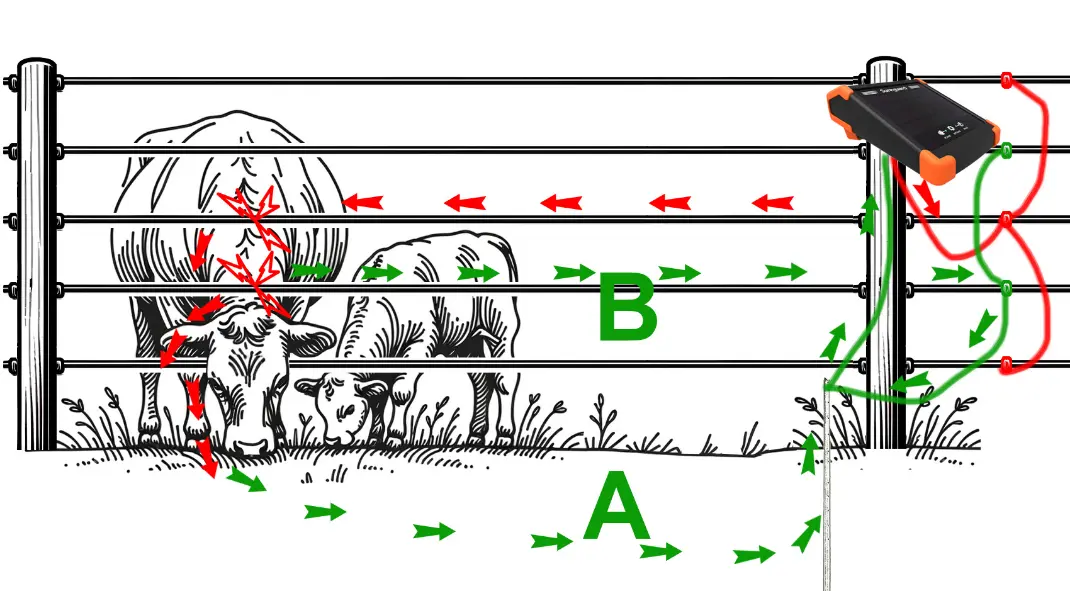Electric Fence Design
You'll find a plentiful supply of information on the internet about electric fencing design. However, if you haven't built an electric fence before, it might be tempting to use a suggested design without understanding how it works. Your situation might not apply to that design and the results could be disappointing. So, the purpose of this page is to outline principles that can guide you in your design process.
Horse & Cattle Electric Fence Products Dog electric fence products
Note: For farm electric fencing, Sureguard only manufacture & sell the fence energisers. You'll need to purchase your electric fence hardware at a rural store.
Contents
How does an electric fence work?
Designing the electric fence wires
Using a single electrified wire
Using several electrified wires
selecting wire for permanent installations
Selecting wire for temporary installations
Designing electric fence earthing
earthing for permanent installations
How does an Electric Fence Work?
A device called an energiser (sometimes called an energizer, fence charger, electric fencer or electric fence controller) generates high voltage impulses between its two output terminals. The impulse is very brief and is repeated every 1 to 2 seconds. The fence design is intended to connect the animal to these two output terminals through these fencing wires. When the electrical impulse passes through a muscle in the animal it stimulates the muscle to contract. If you haven't felt an electric fence before, the best description of the feel is like leg cramp but lasting for just a brief moment. By necessity it is very unpleasant so that it provides an effective deterrent when the animal next encounters the fence. The animal remembers the unpleasant experience and avoids touching the wires again. It is NOT some injury or damage that produces the discomfort but rather the induced muscle contraction that is unpleasant.

Unlike humans, most animals are well covered with an electrically insulating surface such as fur, hide, feathers, etc. So, whereas humans can make skin contact and get a shock with a voltage as low as 100 volts, most animals require a higher voltage in order to feel anything. High voltages produce long distance sparks that will jump the air gap over the animal's insulating surface. The higher the voltage the longer the spark. Typical spark lengths are 1mm (0.04") for every 2000 volts. If you're using a Sureguard energizer this voltage could be as high as 7000 volts which should be able to spark nearly 3.5mm. Importantly, if the electrical impulse does not spark across this gap to the animal's skin then the animal feels NOTHING! Therefore, a higher fence voltage can mean increased reliability or effectiveness for well insulated animals.

It's also important to realise that more voltage does not always mean more discomfort. Perhaps you've experienced a spark from common static electricity? Did you know that such sparks can have voltages of 10, 20 or 30,000 volts! Yet the sensation is generally just a slight pin-prick feel. What's happening here? The nerves on the skin are being stimulated as the electrical discharge dissipates over the surface of the skin. This feels a little unpleasant but nothing like a properly induced muscle contraction from an electric fence.
To induce a muscle contraction, you must have a voltage difference across the ends of the muscle. In other words, the electrical impulse has to go through the animal. It also has to go through the animal in such a way that stimulates many muscles in order to make the overall "feel" unpleasant enough.
How can the muscle contraction be made strong so that it provides an effective deterrent? Firstly, the electric fence energiser must be able to generate sufficient electrical energy (energy is measured in joules). Most electric fence energisers will do this. However, this energy must be delivered to the animal with minimal loss between the energiser and the animal. This requirement needs careful fence design which we'll discuss in the next section.

Using a Single Electrified Wire
Wire height must be correct. Ensure that the animal will touch it.
Use only with animals that regularly see or understand the wire. Not suitable for vermin control.
Keep the distance from animal to earth electrode less than about 500m (1600ft). Essential for vermin control. Highly effective even on the first encounter.
Not suitable for sandy ground or where subsoil moisture is deeper than the depth of the earth electrode.

Use a single electrified wire for:
- Strip grazing where the animals are progressively moved from area to area.
- Permanent grazing.
- Taking the physical pressure off an existing fence.
- Maximum fence length of about 1km (else use multi-wire fence).
In its simplest form, an electric fence is just a single wire placed at a suitable height so the animal cannot avoid touching the wire if it attempts to pass by the wire. The two terminals of the electric fence energiser are designated "live" and "earth". The live terminal is connected to this fence wire. The earth terminal is connected to a metal earth electrode placed in the ground. This system relies on the moisture in the ground to act as a conductor of electricity between the earth electrode and the animal's feet. When the animal touches the fence wire it completes the electrical circuit back to the two terminals of the energiser. The electrical impulse comes off the wire, through the animal's muscles, through its legs into the soil, through the moisture in the soil back to the earth electrode.
The soil must have sufficient moisture for this style of fence to work effectively; sandy or dry soils are not suitable. You CANNOT send the electrical impulse through more than about 1km of soil without it loosing significant power. The multi-wire fence solves this issue.
The single wire system has many advantages. It has minimal materials and so is quick to install and relatively inexpensive. It can be readily dismantled and moved. It's very effective once the animals have learnt to avoid the wire.
Disadvantages mainly relate to its proper application. An animal's initial contact with the wire can have unpredictable results. The wire doesn't physically restrain the inexperienced animal, so initially the animal may pass under the wire. You must position the wire at an appropriate height for the animal. If you have young as well as mature animals, don't introduce full sized animals at the same time as young. Set the wire height for the larger animals & let them learn first. Then reduce the wire height & introduce the smaller animals.

Wire heights must be correct so the animal has to touch two neighbouring wires simultaneously.
Essential for vermin control. Highly effective even on the first encounter.
Suited to any length of fence.
Suited to dry areas.

Use several electrified wires for:
- Long distance electric fence systems.
- Dry areas with little subsoil moisture.
- Vermin control to achieve maximum effect even on the first encounter.
This alternate design carries both live wires & earth wire(s) (alternating live-earth-live etc). The live terminal of the energiser is connected to all of the "live" fence wires. The earth terminal of the energiser is connected to both the earth electrode and the earth wire(s) on the fence. Additional earth electrodes are installed about every 1km along the fence-line and connected to the earth wire. This keeps the ground conduction path under the 500~1000m suggested maximum distance. Dry areas may require shorter distances between earth electrodes.
Selecting the Electric Fence Wire for Permanent Installations
Permanent installations are best constructed using galvanised steel wire. This is the lowest cost, longest lasting, best performing material to use. In Australia the standard sizes of wire are 1.6mm, 2.5mm and 3.2mm. In terms of electrical performance you can use the 1.6mm gauge up to about 10km. Longer fences should be constructed with the heavier gauges to minimise electrical resistance. In terms of physical performance, the 1.6mm wire is adequate for most jobs but you should definitely use a heavier gauge if the fence might suffer physical impact from animals, trees or farm equipment.
Selecting the Electric Fence Wire for Temporary Installations
Use Galvanised wire where possible or practical.
Energise no more than 200m of standard grade poly wire or poly tape.
Use poly tape for visibility if the animals might otherwise run into the fence.
When using poly tape it is essential that you pull the wires free and twist them.
Designing Electric Fence Earthing
Earthing For Permanent Installations
Maximise the surface area of earth electrode in contact with moist soil.
Install earth electrode as deep as possible into subsoil moisture.
If possible, measure the voltage on the earth electrode to ensure it's low enough to be effective.
If you can't achieve an effective earth then don't use a single wire fence.
For temporary installations such as strip grazing or setting up a portable fence around a camp site you may have to rely on a less than ideal earth. Strip grazing is generally a fairly predictable affair so you might want to install a good earth at each location you intend to strip graze. Simply leave the earth electrodes in the ground and connect when required. If you're erecting a fence for just a few days or over night then you probably don't want to be carrying large earth electrodes and a sledge hammer. You could use a metal tent peg a such times provided the fence distances are short and the topsoil is moist.

Electric Fence Insulation

One style of Electric Fence Insulator. They come in many designs.
Buy properly designed electric fence insulators. They will save time & avoid frustration.
Many materials that are considered to be insulators behave unexpectedly at high voltages. Plastics can carbonise and become conductive. Timber holds moisture that can allow current to flow. Surfaces conduct electricity because of moisture. Therefore, if you want to build a reliable electric fence you could save much time and effort by buying components that have been specifically designed for the job. However, if you really want to make do-it-yourself insulators then keep the following points in mind:
- For most plastics the thickness of the material between the high voltage points should be more than 5mm (1/4").
- The distance across the surface of an insulator should be at least 25mm (1") or more if water could accumulate on the surface.
- The insulation on most domestic cables is rated to 600 volts. If you need insulated cable the proper electric fence design is about 6mm thick. You can buy a special cable on this web site that uses silicon rubber. It is flexible and easy to use and rated to 10,000 volts.



